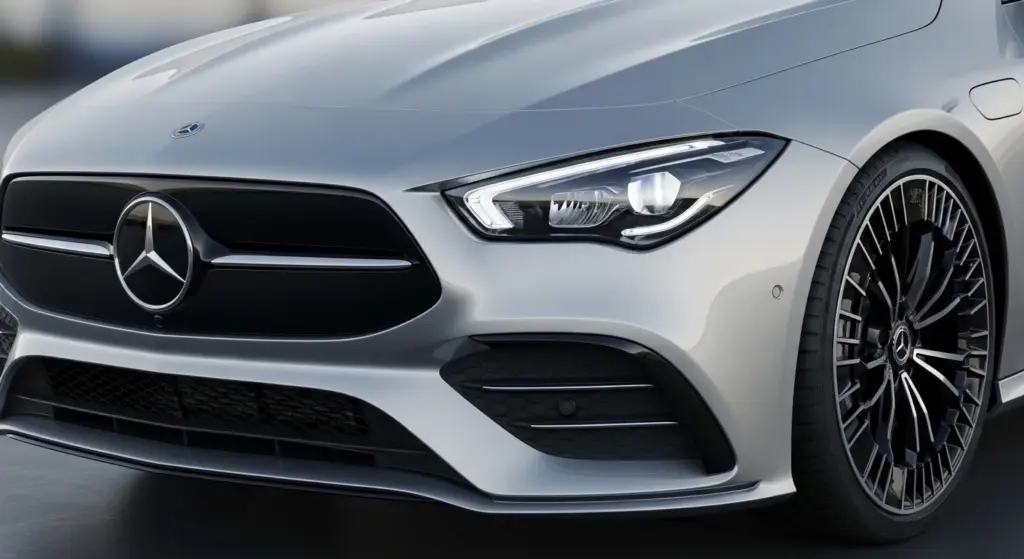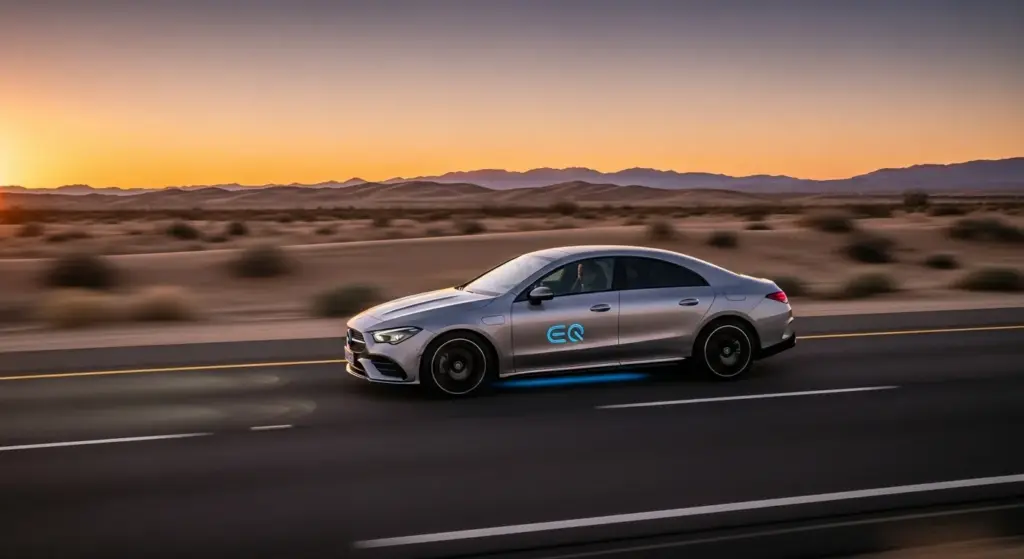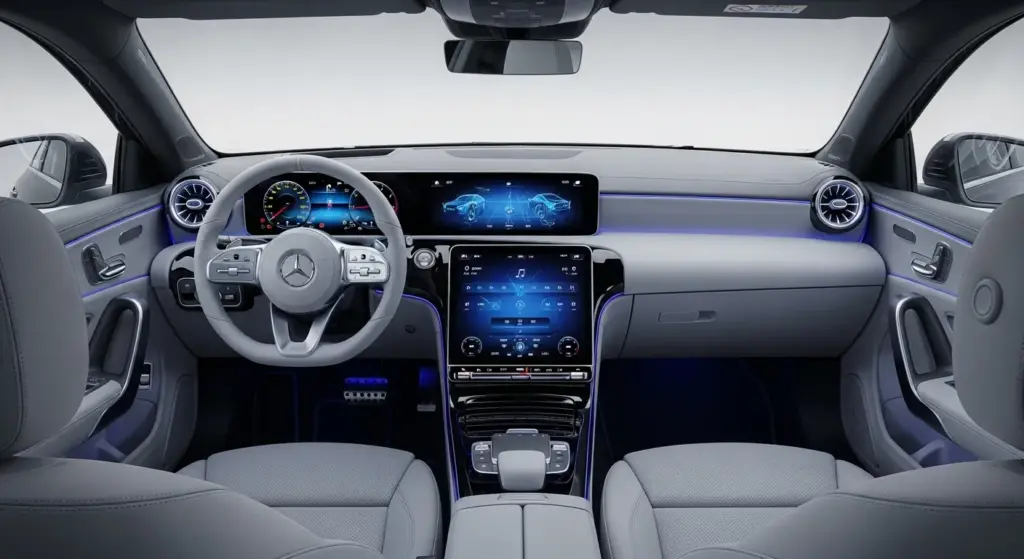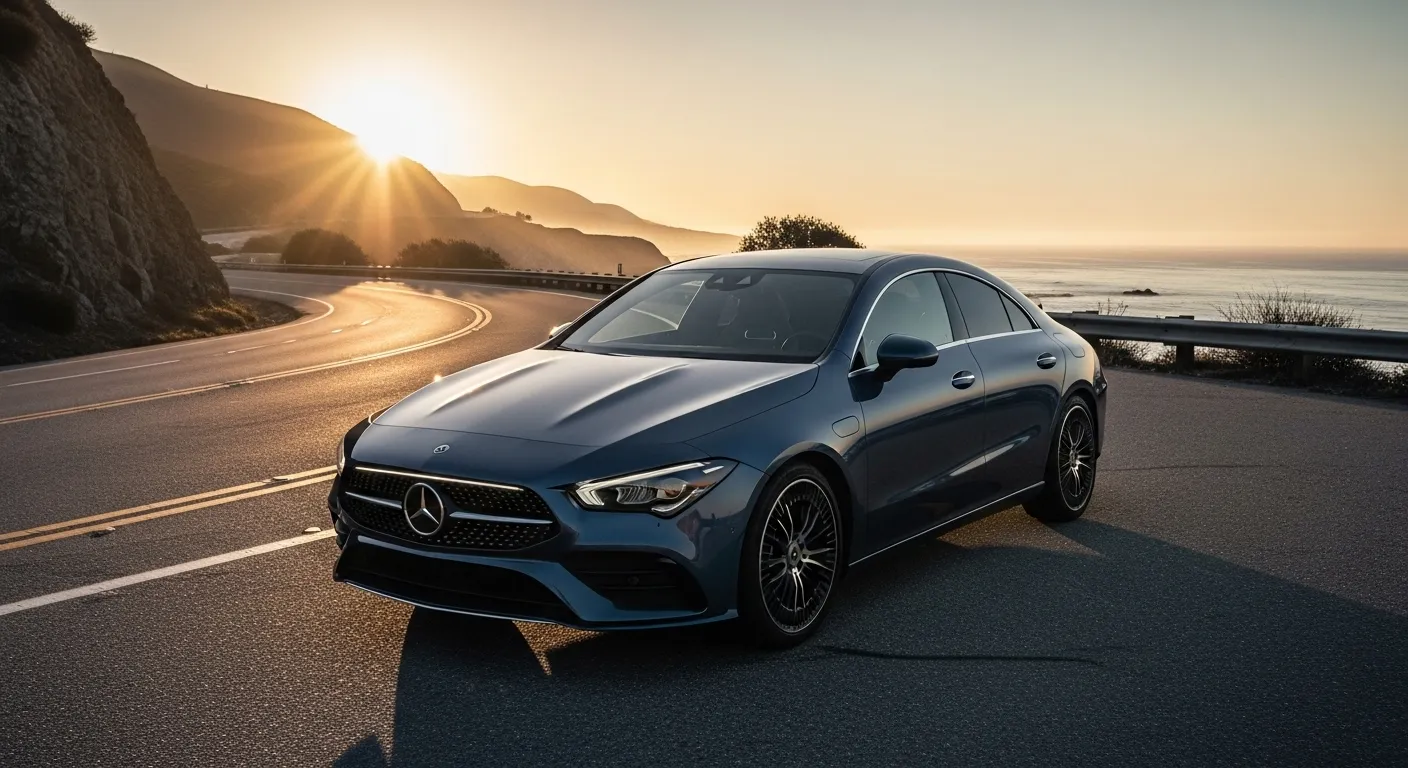Last updated on October 7th, 2025 at 11:48 am
If there’s one car revealing in 2025 getting real traction in media and EV circles, it’s the third-generation Mercedes CLA. Unlike past Mercedes EVs that wore radically different bodies from their combustion siblings, the 2026 CLA is built under a bold new philosophy: same exterior and interior design for both electric and ICE versions.
For U.S. buyers, that means you no longer pay a styling tax just because you opted for electrification. It also signals Mercedes is doubling down on a flexible future, especially as EV incentives shift and demand ebbs and flows.
Market contexts amplify its importance: EV tax credits in the U.S. are under stress, and many OEMs are recalibrating launch strategies. Mercedes has already paused deliveries of some EQ models in the U.S. amid slower than projected demand. In that environment, a car that can straddle both worlds — EV and ICE — offers strategic breathing room.
Imagine yourself on Route 66, plugging in at a fast charger in Flagstaff, then the next morning switching to a hybrid version in Denver if infrastructure is sparse — the new CLA’s design intends to give you that kind of flexibility.
Shared Design, Shared Platform — Why It’s Groundbreaking

One of the most talked-about shifts with this new CLA is how it discards the old “EV-only look” approach. Previously, Mercedes EQ models had distinct styling that differentiated them from gas cars. The 3rd-gen CLA abandons that separation.
Under the skin, it rides on the Mercedes Modular Architecture (MMA) platform, which is engineered to accommodate both electric and combustion powertrains. This dual-capability architecture ensures that models like the gas or hybrid CLA variants will look and feel strikingly similar to their electric siblings — a big shift in Mercedes’ philosophy.
For buyers, that means fewer compromises: you don’t lose aesthetics, you don’t get stuck with an EV body you don’t want, and future resale might benefit from a design continuity that avoids the “EV-only styling age.”
Please take a look at this post as well: Dodge Just Dropped the 2026 RAM 2500, and Truck Fans Are Losing It
Performance & Charging: Real-World Over Promises

Mercedes claims that the electric CLA can support 320 kW DC fast charging under ideal conditions. In real-world tests, though, the car has pushed beyond expectations: a YouTuber’s road-trip test saw peaks of 349 kW for a few minutes. Over the first 10 minutes of charging, output remains strong — then tapers off as battery levels rise.
Here’s a clean summary table of what we know so far:
| Specification | CLA 250+ (RWD) | CLA 350 4MATIC (AWD) |
|---|---|---|
| Peak DC Fast Charge | ~320 kW (tested up to ~349 kW) | same architecture |
| Power | ~268 horsepower | ~349 horsepower |
| Torque | 247 lb-ft (approx) | 380 lb-ft (approx |
| 0–60 mph (prelim) | ~6.6 s | ~4.8 s |
| Top Speed | 130 mph limited | same limit |
| Charging (10 min) | ~201 miles possible (per Mercedes) | similar |
| Range (WLTP estimates) | ~694–792 km equivalent (European cycle) | ~672–771 km (WLTP) |
Please take a look at this post as well: 2026 Toyota RAV4 Goes Fully Electrified — Hybrid Power, Fast Charging, and a Bold New Look
Real-life Impact:
On a highway drive, that charging capability means you could get 150–200 miles in 10 minutes if you hit an 800V charger — provided you’re in the low-state-of-charge window. That opens up meaningful road-trip usability. The two-speed transmission on the drive axle is also smart — it helps maintain efficiency at higher speeds without sacrificing low-end torque.
However, efficiency will vary depending on temperature, load, and charger type — meaning in hot-weather climbs or lower-power DC stations, you’ll see tapering power curves. The architecture’s ability to integrate a 400V DC converter (for compatibility with more charger types) is claimed to arrive later, mitigating charger availability concerns.
For daily commuting, expect reliable efficiency and responsive drive. On longer trips, you’ll want to plan your stops carefully — but this car is among the most competitive yet for bridging the EV long-range gap.
Sustainability & Material Innovation: Low-Carbon Aluminum

News hit recently that Mercedes-Benz is leveraging low-carbon aluminum in the manufacture of its electric CLA, cutting CO₂ emissions by around 40 %, compared to earlier models. This aluminum is produced with renewable energy and includes a high proportion of recycled scrap.
This move is not just marketing — it helps the CLA’s lifecycle emissions profile become more competitive, especially in an era when regulators and conscious buyers increasingly scrutinize production emissions. For the U.S. buyer, this could also become a selling point in states or incentives that reward green manufacturing practices.
Please take a look at this post as well: This Ducati Diavel V4 RS Is Faster Than Most Superbikes
How It Stacks Up & Market Risks
Against Rivals:
- Compared to a Tesla Model 3 or BMW i4, the CLA emphasizes design parity with ICE models and smart architecture flexibility.
- The two-speed gearbox is a differentiator; most rivals use single-speed drives.
- Its efficiency-first approach (rather than brute power) sets it apart from muscle-Tesla models, focusing instead on usable range and real-world performance (a “less-is-more” philosophy).
Against its predecessors:
- The previous CLA versions (ICE-only) were entirely separate from any EV counterpart. Now, the transition to shared design is a step-change.
- The AMG CLA 45 S Final Edition has already been announced as a farewell to the current generation, delivering 416 hp and 369 lb-ft of torque.
Market Risks & Challenges:
- Mercedes recently paused deliveries of EQ-branded vehicles in the U.S. due to weak demand and inventory overhang.
- The end (or scaling back) of federal EV tax credits in 2025 threatens buyer incentives.
- Even though the CLA is not strictly an “EQ model,” its fate could be tied to how Mercedes positions its EV roadmap and manufacturing strategy in the U.S.
- Charger availability (especially high-power 800V stations) will remain a practical constraint for many drivers until the infrastructure catches up.
What’s New, What’s Coming, What to Watch
Launch Timing: The 2026 CLA electric models are slated to arrive later in the year in the U.S., with hybrid/gas versions following.
Charging Flexibility: U.S.-spec models are expected to include the 400V-to-800V converter as standard, giving access to more DC fast charger types.
Production & Demand: Due to favorable initial interest, the CLA’s production in Rastatt (Germany) is reportedly being ramped up with additional shifts.
Interior & AI OS: The vehicle debuts Mercedes’ new MB.OS (Mercedes-Benz Operating System), integrating AI voice control (Google, Microsoft) with the 4th-generation MBUX framework.
Design Backlash & Strategy Shift: Some critics have called Mercedes’ decision to unify styling for EV and ICE “bland,” accusing them of losing the distinct EV identity. But Mercedes defends this as a mature phase in EV adoption, where differentiation is less necessary.
Pricing Uncertainty: U.S. pricing is not yet confirmed; international benchmarks suggest the CLA will sit in the premium compact segment.
Who Should Care — And Who Should Wait
If you’re a daily commuter in California, the Northeast, or any region with reliable DC fast charging, the electric version of the CLA is an enticing pick: refined, efficient, future-facing. For hybrid adopters or buyers in more infrastructure-challenged regions, the gas or hybrid sibling may offer peace of mind.
But if you’re chasing outright brute performance, or you frequently roam areas with sparse charging infrastructure, it may still be wise to wait for more reviews or even a plug-in hybrid variant.
Ultimately, the third-gen CLA is a smart bet if you believe the EV and ICE worlds will increasingly converge, and if you want to hedge your purchase with flexibility. It’s a bold move from Mercedes — ambitious, not without risk, and exactly the kind of car to watch in 2025–2026.
